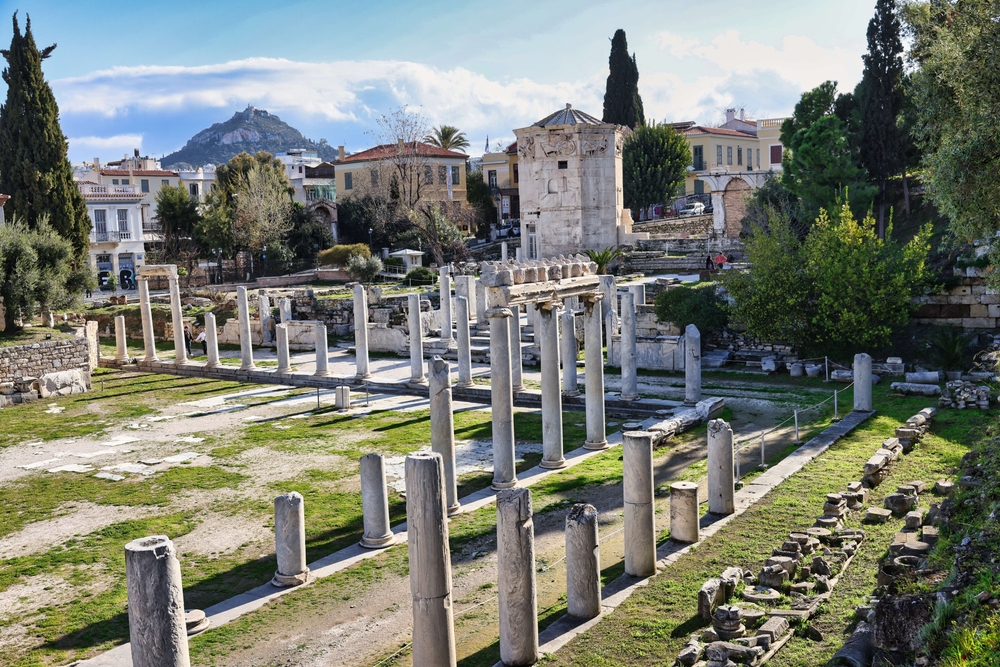Visiting Hadrian’s Library in Athens is like stepping into history—but with limited signage and layers of ruins, it’s easy to miss the true significance of this ancient marvel. Without understanding its rich past, a quick stroll might leave you feeling underwhelmed. Our guide unravels the library’s importance as a cultural and intellectual center, ensuring you don’t just visit but experience the full grandeur of Emperor Hadrian’s vision.
What is Hadrian’s Library in Athens, and why is it significant?
Hadrian’s Library in Athens was built in 132 AD by the Roman Emperor Hadrian as a cultural and intellectual center. It housed over 17,000 books and scrolls and included reading rooms, lecture halls, and a central courtyard. The library played a key role in promoting learning and philosophy in ancient Athens, but over centuries, it was repurposed and reconstructed after invasions. Today, its ruins offer a glimpse into the grandeur of Roman Athens and its rich cultural history.
Getting to Hadrian’s Library
Hadrian’s Library is conveniently located just north of the Roman Agora, adjacent to bustling Monastiraki Square. This central location makes it easily accessible from multiple key landmarks.
- By Metro: Take metro lines 1 or 3 to Monastiraki Station, and from there, it’s only a 2-minute walk to the library entrance.
- Hop-On Hop-Off Bus: Another convenient option is the Athens hop-on hop-off bus, which stops at Station A14 Monastiraki/Thissio, placing you just a short walk from the library.
- Nearby Attractions: Due to its prime location, visiting Hadrian’s Library is often combined with nearby historical sites like the Roman Agora, Tzistarakis Mosque, and the Acropolis.
Tip: Plan your visit early in the day to avoid crowds, especially if you’re visiting during peak tourist season.
History of Hadrian’s Library
Built in 132 AD by Emperor Hadrian, this ancient library was part of the Roman emperor’s plan to transform Athens into a cultural and intellectual center of the empire. The library housed over 17,000 books, scrolls, and papyri, serving as both a repository of knowledge and a venue for philosophical discussions and lectures.
At its height, the library featured a grand courtyard surrounded by 100 columns made of marble, lecture halls, and reading rooms. However, its fortunes were short-lived. In 267 AD, the Herulians, a Germanic tribe, sacked Athens, damaging the library. Though it was rebuilt, further invasions and eventual use by Byzantine and Ottoman rulers altered its structure and purpose over the centuries.
Today, the remains of Hadrian’s Library offer a glimpse into its once-grand design, with surviving elements like the Corinthian columns and some of the original niches used to store scrolls.
Must-See Features at Hadrian’s Library
Exploring Hadrian’s Library reveals several standout features that highlight its historical and architectural significance:
- Main Courtyard: Once the centerpiece of the library, this large courtyard was surrounded by colonnades and exedrae (semi-circular seating areas). You can still see traces of the pool and garden that once adorned this space.
- Library Rooms: Although much of the structure is in ruins, visitors can see remnants of the rooms where thousands of scrolls and documents were stored. Look closely at the remaining niches and imagine the wealth of knowledge that once filled these walls.
- Byzantine Church Ruins: After the library’s destruction, a large basilica was built on the site during the Byzantine period. The ruins of this church are still visible today, offering insight into the library’s transformation over time.
- Corinthian Columns and Façade: The striking Corinthian columns at the entrance are among the most impressive features that remain. These towering pillars once greeted visitors to the library, serving as a symbol of Hadrian’s ambition to create a cultural beacon in Athens.
Tips for Visiting Hadrian’s Library
To make the most of your visit, consider these practical tips:
- Tickets: We recommend you to purchase skip-the-line Hadrian’s Library ticket to avoid the long lines.
- Opening Hours: The site is open year-round, but be sure to check seasonal hours before you visit. Admission is free on certain Greek holidays, such as March 6th and the first Sunday of every month from November to March.
- Best Time to Visit: Arrive early in the morning or late afternoon to avoid the midday heat and the majority of the crowds.
Tip: Take advantage of a guided tour or an audio guide to fully appreciate the historical and architectural details that might be missed during a casual visit.
Hadrian’s Library Skip-the-Ticket-Line Ticket by MegaPass
Explore the ancient grandeur of Hadrian’s Library, a stunning relic of Roman architecture, built during Emperor Hadrian’s visit to Athens in 131-132 A.D. This cultural hub once served as a center for learning, housing thousands of scrolls and offering a venue for public lectures and worship. With the MegaPass Skip-the-Ticket-Line Ticket, you can immerse yourself in history without the hassle of waiting in lines.
Highlights:
- Roman Architecture: Marvel at the monumental Corinthian columns and the impressive gateway that greets visitors, showcasing the architectural prowess of ancient Rome.
- Cultural Hub: Learn about the library’s multifunctional role in Athenian society, serving as a space for reading, lectures, and even religious worship.
- Historical Layers: Witness the remnants of Byzantine churches, including a church from the 11th century, built on the ruins of the library.
- Interior Courtyard: Imagine the library’s grand courtyard, once filled with marble columns, alabaster roofs, and decorative art, reflecting its cultural and intellectual importance.
With the MegaPass, a popular Athens tourist pass, you’ll skip the ticket lines and delve straight into the rich layers of history at Hadrian’s Library. Explore at your own pace, taking in the site’s intricate history and architectural beauty.
Nearby Attractions

When visiting Hadrian’s Library, you’ll find yourself in the heart of Athens, surrounded by several other significant historical sites that are just a short walk away:
- Roman Agora: Located just north of Hadrian’s Library, the Roman Agora was a marketplace built by Roman rulers, showcasing remnants of ancient shops, a fountain, and the Tower of the Winds, an ancient timekeeping and meteorological structure.
- Acropolis and Parthenon: No visit to Athens is complete without exploring the iconic Acropolis, which looms above the city. The Parthenon, dedicated to Athena, sits atop the Acropolis and offers breathtaking views. For first-time visitors, Acropolis skip-the-line tickets are a must to avoid long waits, especially during peak tourist season.
- Monastiraki Square: Just steps from Hadrian’s Library, this vibrant square is home to lively markets, shops, and cafes. It’s also where you can visit the Tzistarakis Mosque, which reflects the Ottoman influence in Athens.
- Ancient Agora of Athens: A short walk from Hadrian’s Library, the Ancient Agora was the heart of public life in ancient Athens. You’ll find significant landmarks like the Temple of Hephaestus and the Stoa of Attalos, now a museum.
Conclusion
Hadrian’s Library may not be as well-known as the Acropolis, but it remains one of Athens’ most significant historical landmarks. This ancient center of learning is a must-visit for anyone interested in Roman history, architecture, and the layered cultural transformations that shaped Athens. With its proximity to other famous sites and its affordable ticketing options, Hadrian’s Library offers a glimpse into the intellectual heart of ancient Athens.
Ready to explore Hadrian’s Library in Athens? Secure your skip-the-line ticket and start your journey through time at this monumental site!


Leave a Reply